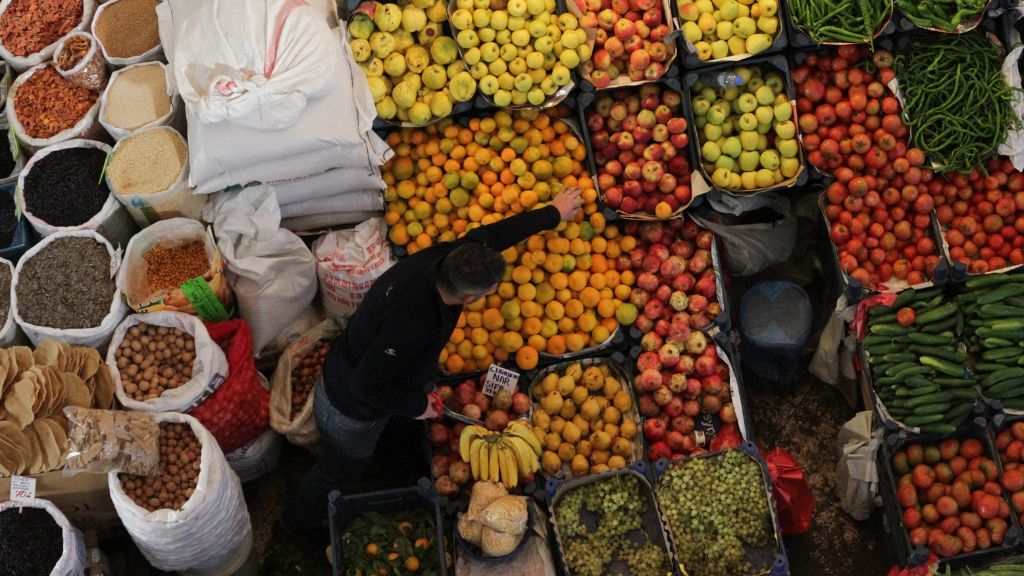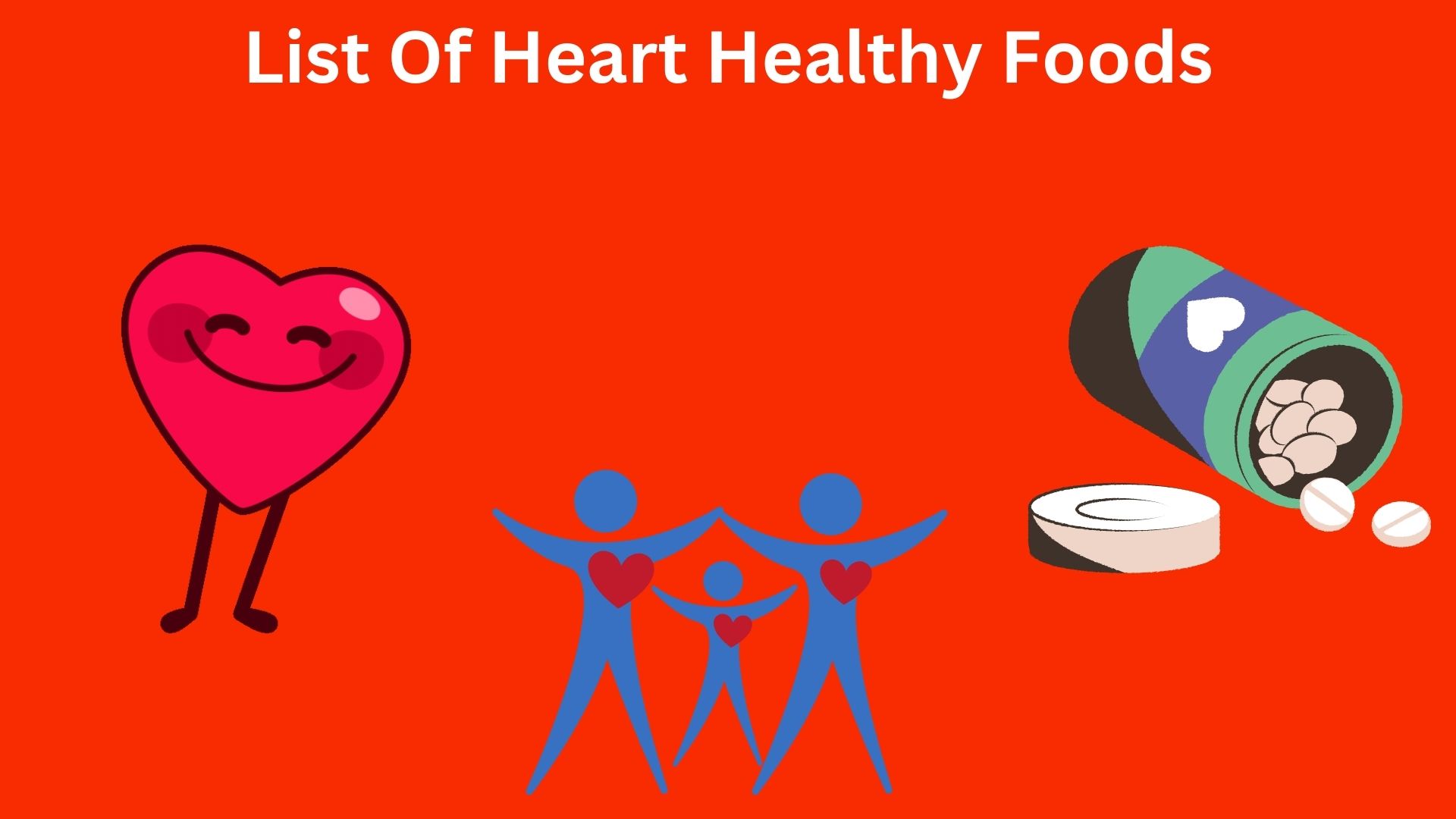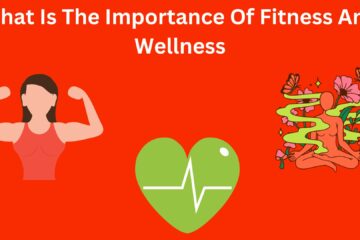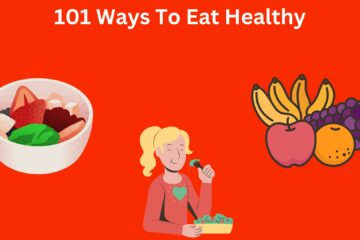Heart disease is the leading cause of death in the world and a major public health concern. But did you know that the foods you eat might have a significant impact on your cardiovascular health? You can minimize your risk of heart disease and increase general health and well-being by consuming heart healthy foods.
So, what are the finest heart-healthy foods? While there is no one-size-fits-all answer to this topic, certain meals are routinely advised by health experts as being especially beneficial to the heart. Fruits and vegetables, whole grains, lean proteins, and healthy fats are examples.
In this blog post, we will look at a list of heart healthy foods that can help maintain your heart healthy and powerful. We’ll go through the top foods to include in your diet to support heart health, as well as some ideas on how to incorporate these foods into your meals and snacks. This list is a wonderful place to start if you want to prevent heart disease or manage an existing condition. So, let us begin our quest to better heart health.
10 Heart Healthy Foods
1. Fruits and vegetables
Fruits and vegetables are high in nutrients while being low in calories, making them excellent choices for cardiovascular health. They are high in fiber, vitamins, minerals, and antioxidants, all of which promote general health and well-being.
Fruits and vegetables are also low in saturated fat and cholesterol, lowering the risk of heart disease. Apples, berries, leafy greens, tomatoes, and sweet potatoes are examples of heart-healthy fruits and vegetables.
To maximize the benefits for heart health, it is typically recommended to consume a wide variety of different fruits and vegetables as part of a balanced and varied diet. When feasible, pick fresh, whole fruits and vegetables over processed or packaged ones, which may include added sugars and other unhealthy substances.
2. Whole grains
Whole grains are high in fiber, which can help lower cholesterol and lower the risk of heart disease. They are also high in other nutrients, like B vitamins and minerals, which are essential for overall health and well-being.
Whole grains, as opposed to refined grains, which are processed and depleted of many nutrients, are unprocessed and contain all portions of the grain, including the bran, germ, and endosperm. As a result, they are a more nutritious option than refined grains.
Whole grains that are good for your heart include oats, quinoa, brown rice, and whole wheat. As part of a healthy and balanced diet, it is typically recommended to consume at least 3 ounces of whole grains every day.
3. Lean proteins
Lean proteins like poultry, fish, and tofu are low in saturated fat and can help lower cholesterol and the risk of heart disease. They are also high in other nutrients, like as B vitamins and minerals, which are essential for overall health and well-being.
Poultry and fish are especially ideal sources of lean protein since they are lower in fat and calories than other types of protein, such as red meat. Tofu is a high-quality plant-based protein that is low in fat and calories.
As part of a healthy and balanced diet, it is generally recommended to consume a variety of various protein sources. To help minimize the risk of heart disease, pay attention to portion sizes and pick lean cuts of protein whenever available.
4. Healthy fats
Healthy fats like olive oil, avocado, and almonds can help lower cholesterol and lower the risk of heart disease. Healthy fats, as opposed to saturated fats, which are hazardous to heart health, are unsaturated and can actually aid to promote heart health.
Olive oil is high in monounsaturated fats, which have been linked to decreased cholesterol and a lower risk of heart disease. Avocado is high in fiber and other minerals, as well as a good source of monounsaturated fats. Almonds and walnuts, for example, are strong in monounsaturated fats and are a wonderful source of protein and other nutrients.
Healthy fats should be consumed in moderation as part of a healthy and balanced diet. It is also critical to select healthy fats over bad fats like saturated and trans fats, which can contribute to heart disease.
5. Legumes
Beans, lentils, and chickpeas are high in fiber and protein and can help lower cholesterol and lower the risk of heart disease. They are also high in other minerals including iron, folate, and potassium.
Legumes are an excellent plant-based protein source that can be utilized in place of animal proteins in meals and snacks. They are also low in fat and calories, making them a heart-healthy and nutritious option.
As part of a healthy and balanced diet, it is typically recommended to consume a range of various bean kinds. Legumes can be eaten alone or added to recipes to increase protein and fiber content. They can also be used in place of meat in meals like chili, soups, and stews.
6. Herbs and spices
Many herbs and spices, including garlic, turmeric, and ginger, contain antioxidant and anti-inflammatory qualities that can aid in heart health. They are also a wonderful source of vitamins and minerals, and they can provide taste and diversity to meals and snacks.
Garlic, for example, has been demonstrated to cut cholesterol and lower the risk of cardiovascular disease. Turmeric is an antioxidant-rich spice with anti-inflammatory benefits. Ginger, a spice, has been demonstrated to lower blood pressure and the risk of heart disease.
As part of a healthy and balanced diet, it is typically recommended to integrate a variety of herbs and spices into your diet. They can be used to flavor dishes without the use of unhealthy components like salt and sugar.
7. Dark chocolate
Dark chocolate has a lot of antioxidants, which can help lower blood pressure and lower the risk of heart disease. It also contains important nutrients including iron, magnesium, and zinc.
It is crucial to note, however, that not all chocolate is created equal in terms of heart health. Dark chocolate, which is composed of cocoa solids, cocoa butter, and sugar, is widely regarded as the healthiest alternative. Milk and white chocolate, on the other hand, are less healthful due to their sugar and fat content.
Dark chocolate should be consumed in moderation as part of a healthy and balanced diet. It is also critical to select high-quality dark chocolate manufactured with cocoa solids rather than cocoa powder, as cocoa solids contain more antioxidants.
8. Fatty fish
Fish strong in omega-3 fatty acids, such as salmon, mackerel, and sardines, can help lower cholesterol and reduce the risk of heart disease. Omega-3 fatty acids are a form of unsaturated fat that has been linked to a variety of health advantages, including decreased inflammation and improved heart health.
Fatty fish are also high in protein, vitamins, and minerals, making them a nutritious and healthful choice for general health and well-being.
As part of a healthy and balanced diet, it is generally recommended to consume fatty fish at least twice each week. Other omega-3 fatty acid sources, such as nuts and seeds, can be added to the diet to assist fulfill the necessary amount.
9. Green tea
Green tea contains a high concentration of antioxidants and has been demonstrated to lower cholesterol and lower the risk of heart disease. It’s also high in nutrients like catechins and flavonoids, which have been linked to a variety of health advantages like lowering inflammation and increasing heart health.
Because of its increased antioxidant content, green tea is typically thought to be a better choice than other forms of tea, such as black tea. It also contains less caffeine than other caffeinated beverages, such as coffee, making it a good alternative for caffeine-sensitive individuals.
Green tea should be consumed in moderation as part of a healthy and balanced diet. To assist maximize the health advantages, buy high-quality green tea and avoid adding sugar or other unhealthy additions like cream or syrup.
10. Nuts and seeds
Nuts and seeds strong in fiber and good fats, such as almonds, chia seeds, and flaxseeds, can help lower cholesterol and reduce the risk of heart disease. They are also high in protein, vitamins, and minerals, making them a nutritious and healthful choice for general health and well-being.
Nuts and seeds include monounsaturated and polyunsaturated fats, both of which are considered healthy fats that can help decrease cholesterol and enhance heart health. They are also high in omega-3 fatty acids, which have been linked to a variety of health advantages such as reduced inflammation and improved heart health.
As part of a healthy and balanced diet, it is typically recommended to consume nuts and seeds in moderation. To help limit your intake of additional salt, consider unsalted nuts and seeds whenever possible.
Heart Healthy Diet: 8 Steps To Prevent Heart Disease

You are probably asking if there is anything that I should be eating for my health and well-being. The answer is yes. I’ll tell you how I started my journey with the list. It can be difficult to make dietary changes when it appears that eating certain foods increases a person’s cardiovascular risk. I will provide you with a list of eight health-promoting and delicious diets that will help you improve your overall health. Once you know which foods to eat and how to limit your intake, it will lead to better heart health.
1. Eat more vegetables and fruits
Vegetables and fruits contain a good amount of fiber and are rich in nutrients. These are the best sources of vitamins and minerals and may reduce the risk of vascular diseases. Eating a little more fruits and vegetables helps you reduce calories from various foods, including meats, cheeses, and snacks. The addition of vegetables and fruit is quite easy. You just put the veggies in the fridge after cleaning for a quick snack. Storing fruits on the floor so that they can be kept for later consumption is also an idea.
2. Choose low-fat protein sources
Lean meat and poultry are good sources of protein. You should go for less-fattening products like skinless chicken breasts, baked patties, skim milk, or pure milk. Fish are also good alternatives to meat that contains excessive amounts of fat. Certain fish species have a lot of omega-3 fat-reducing agents such as triglycerides. Most omega-3 fatty acids are found in cold-pond salmon, mackerel herring, and salmon. Another source is soybeans, oats, and canola oils.
3. Allow yourself an occasional treat
It is illogical to believe that a candy bar and a chip will harm your health and well-being. This should not be an excuse for putting off your food plan. Taking a long-term approach to excessive consumption is an ideal solution. Eating good food is important because if we incorporate these eight tips into our lives, heart-healthy food will be both possible and enjoyable. You could even prepare a meal with just a simple substitution.
4. Limit unhealthy fats
Limiting the saturated fat, you consume is important for reducing triglycerides and heart disease. A high blood cholesterol level is correlated with plaques forming the arterial wall, which increases the risk of cardiovascular disease or stroke. The American Heart Association recommends the following fats that should be in an American diet: You can easily reduce your fat consumption by examining the food labels of cookies, cupcakes, and cakes.
5. Plan ahead: Create daily menus for heart healthy foods
Making a daily menu by following these six strategies is very important. When choosing foods for meals or snacks, emphasize vegetables and fruits. Use a safflower protein source to avoid salt. Take care of your portions as well as change your menu selections. Try making a black bean hamburger the next night after grilling fish. It ensures that your body has all the nutrients necessary to function properly.
6. Limit or reduce salt (sodium)
We all know that ingestion of too much salt increases blood pressure and causes heart attacks. Reducing salt (sodium) will also help to keep your heart healthy. The American Heart Association recommends reducing salt in food when a recipe is prepared, by lowering the amount. Eating fresh foods and making soup or stew are two other ways to reduce salt consumption. You can also buy canned soups with reduced sodium without adding more salt.
7. Control your portion size
How much food you eat matters much more than how you eat it. Overdosing and consuming too many calories can make you eat more than you should if you are hungry. You should know that restaurant menus tend to have more calories than everyone else’s. Keeping a good balance between eating and exercise is essential to reducing body fat.
8. Select whole grains
Whole grains are a source of fiber, which is essential for controlling cholesterol. You can eat more whole grains for your health by using substitutes for refined grains in your diet. Or you could go on an adventure and try something entirely different, like quinoa and barley. Interesting, isn’t it?
Other Heart Healthy Foods
1. Meat, poultry, fish, and plant-based proteins
Byrd Watson advises us against high-fat and processed meats like sausages and smoked meats. Processed meat and the use of saturated oils also increase the risk of pulmonary disease. You should also give red meat some extra thought, you know? A new study shows eating meat increases a circulatory molecule known as TMAO and can also cause heart disease. There is no reason to never enjoy steaks or hamburgers if you only choose these more.
2. Good protein options
Good proteins probably won’t increase your risk of cardiovascular disease, but they don’t lower it either. Researchers have been investigating the link between diet and fatty livers. The consensus is to focus more on the diet than the elimination of foods containing fatty acids, such as eggs and shellfish.
3. Fruits and vegetables
Fruit is the foundation of a healthful diet. These nutrients are linked with decreased blood cholesterol, calcium, magnesium, and other phytonutrients. I’ll give you all the food that’s good for you. For maximum impact in your grocery shop, choose different colors. Discover the significance of eating rainbow-colored fruits and vegetables. Freeze food often and keep an eye on added sugars and salts.
4. Desserts
Dark chocolate contains flavonoids that are linked to a lower cardiovascular risk. Fruits are a better option, though. Other dessert products often contain high amounts of sugar, which increase the risk of heart disease. A delicious dessert can either be enjoyed at a special moment or made in your own home. Our heart-healthy dessert recipes contain less saturated fat and sodium and usually use less sugar or whole grain. Get the recipe from our experts.
5. Snack aisle
The snack aisles have changed dramatically over time and offer heart-healthy choices. Sneakier advertising claims can be mistaken too, so read labels. Butz recommends keeping salt below 140 mg per serving, added sugar below 3 g per serving, and saturated fat below 3 g per serving. Fresh fruits and veggies are good snacks, but here’s one shopping secret: always check the label!
6. Sauces, condiments, and spices
Buying heart-healthy food is sometimes difficult at grocery stores. Heart-friendly food shouldn’t just be bland. Reduce products with high-fat content, salts, or sugars. To reduce your risk of coronary artery disease, look for dressings and condiments made with olive or canola oil.
7. Consume as many calories as possible
Physical activity is essential for maintaining a healthy weight, a healthy heart rate, and maintaining vascular health as we age. When you have no time to exercise regularly, look for a good option. It is best to plan activities throughout the week.
8. Freezer Aisle
Frozen food has also progressed, focusing on healthier options. Nevertheless, many of these foods contain high levels of salt and saturated fat.
Frequently Asked Questions About Heart Healthy Foods
Cooking a meal I’ll mention six types of warm Asian food, including meat tenders. Grilled chicken and rice with onions and tarragon. Cooked cod with lemon and capers. Baked macaroni with red sauce or baking oatmeal. Salmon baked in a Southeast Asian marinade cereal with 6 grams of pork, chicken, rice, onions, and tarragon. Baked cod with lemon and capers. Baked macarons and oat-based sauces. Cooked salmon with a South Asian marinade.
Avoid foods marked with “trans,” “heated,” or “partially hydrogenated” on their labels. These indicate bad fats. In addition to recognizing calories, you need to know the sugars in your diet.
The AHA recommends a balanced overall diet that includes a variety of fruits and vegetables as well as grain products, particularly whole grains.
Cardiacs are designed to reduce the consumption of food during specific meals. These meals usually contain a protein source complemented by fruit, veggies, and toast. In this, salt and pepper are the only spices allowed. Dessert is also allowed, but at least once a month at dinner.
Berries. Blueberries are a combination of berries and strawberries. This fruit is associated with a lot of health advantages, such as reduced inflammation in the heart and improved cardiovascular functions. Berries provide a good source of fiber and vitamin C.
Conclusion
To summarize, many people are concerned about their heart health, and the foods they eat can have a significant impact on their heart health. We can minimize our risk of heart disease and increase general health and well-being by choosing wise eating choices.
This blog’s list of heart healthy foods offers a wide range of foods that are routinely suggested by health experts as being especially beneficial to the heart. Fruits and vegetables, whole grains, lean proteins, and healthy fats are examples. Each of these foods is abundant in nutrients while being low in dangerous components like saturated fat and cholesterol, making them excellent choices for heart health.
By including these heart-friendly foods in your diet, you may help keep your heart strong and healthy, lowering your risk of heart disease. So, make these meals a regular part of your diet to take the first step toward better heart health.




[…] Fermented foods have long been a mainstay in many civilizations, and for good reason. These foods are high in probiotics, which are helpful microorganisms that can help sustain a healthy diet for gut health. […]